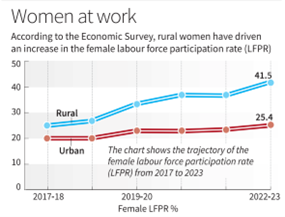- The Chief Economic Adviser in the Economic Survey observed that India is transitioning from women’s development to women-led development.

- A 218.8% increase in budgetary allocation for women’s welfare and empowerment schemes, acknowledging the “motherhood penalty” that leads to a drop in female labour force participation around childbearing years.
- It highlighted that the share of the Gender Budget in the total Union Budget increased to 6.5% in the financial year 2025, the highest since the Gender Budgeting Scheme was introduced in 2006.
| Care Economy • Addressing the care economy, the Survey estimated that public investment equivalent to 2% of GDP could generate 11 million jobs in the sector, with nearly 70% going to women. • It referenced care economy models from Australia, Argentina, Brazil, and the U.S. • According to the International Labour Organisation (2018), the care sector is one of the fastest-growing sectors globally, with investments expected to generate 475 million jobs by 2030. |
| Factsheet • The Pradhan Mantri Kaushal Vikas Yojana (PMKVY) saw an increase in women’s participation from 42.7% in 2015-16 to 52.3% in 2023-24. • Under the Jan Shikshan Sansthan (JSS) scheme, women constituted about 82% of beneficiaries. • In ITIs and National Skill Training Institutes, women’s participation rose from 9.8% to 13.3%. • The Survey noted a rise in the female labour force participation rate (LFPR) from 23.3% in 2017-18 to 37% in 2022-23, driven by rural India. • The Pradhan Mantri Jan Dhan Yojana facilitated the opening of 52.3 crore bank accounts, with 55.6% held by women as of May 2024. |
Dig Deeper: Read about the Female Labour Force Participation Ratio. Which organisation publishes it?

